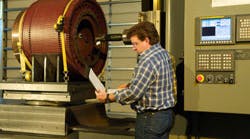“I did not even know what an insert was,” recall Bryan Faircloth. He’s now Bradleys Electric Motors’ CNC programmer and manufacturing manager.
Thanks to its investment in horizontal machining, Bradleys is building its own 1,500-HP AC electric motors.
Bradleys Electric Motors in Corpus Christi, Tex., is a well-known name in all aspects of motor repair, serving sizes from a fraction of a horsepower to 25,000 horsepower. In 2008, the company invested in three CNC machines, including a Sunfirm CST 4160 lathe (46 x 27 x 55-in.), an Atrump M-class vertical milling machine with Centroid controls, and a horizontal milling machine model HMC-100 from Machining Systems Inc. The new HMC was modified to accommodate a 72-in. horizontal, 60-in. vertical, and 40-in. Z-axis as well as an integrated four-pallet changer and 48-piece tool changer.
Prior to these machines being installed, Bryan Faircloth had been Bradleys’ Quality and safety manager. Along with two other machinists, Bryan attended CNC programming classes to learn to operate the equipment. After one machinist became sick and missed the course, and the other machinist headed to another opportunity, Bryan took on the shop floor responsibilities as well as the title of CNC programmer and manufacturing manager. Along with this, he inherited some tooling.
"At this point" said Faircloth, "I did not even know what an insert was. A friend of mine, Javier Martinez, who worked at Extreme Tool, told me he was a Seco Tools distributor. Javier came in along with Seco Tools technical specialist Brian Joshlin, who said ‘let’s try this tool on the lathe,’ establishing our first successful joint project."
The turning point
Faircloth added: "Brian came in about once a month; he’d basically stand there and train me. Not only did he say this tool will work, … he showed us how."
At this point, Faircloth had been calling various tooling suppliers to find a large tap needed to produce a sole plate component. Previously manufactured by outside sources, the company was bringing it in-house to run on the new vertical mill. This 20X14X2-in. plate supports large motors and must be rigid enough to secure bolting to the I-beam. This calls for creating a substantial thread, which was being achieved by first creating the bolt holes using a 1.25-in. tap, and threading after that. The taps would only get through 3 – 4 parts before breaking.
When Faircloth contacted Seco, Joshlins suggested using Seco’s threadmills, which helped improve both production and safety on the sole plate. This was the catalyst that opened the door to Bradleys Motors’ relationship with Seco.
The clincher was Seco’s ability to streamline Bradleys’ processes on a unique boring job for a 30X46-in. stator frame, which required completing a 30.313-in. diameter bore through the entire length. No supplier could deliver a qualified boring tool in less than five to six weeks.
Prior to the investment in the HMC, the workpiece was placed on end in a vertical turret lathe during the boring operation. This was awkward and time consuming. "Just imagine having this huge motor sitting on top of a turret lathe spinning at 200-300 RPM," commented Joshlin. He suggested using Seco’s aluminum, lighter-weight Jumbo Bridge Bars. With the new CNC milling center capabilities (X = 60 in., Y = 72 in., Z = 40 in.), the company was able to switch the stator boring operations to that equipment, running it at 200 ipm with a 0.008-inch feed per tooth. "Now," said Faircloth, "we bore-out the entire diameter in 45 minutes; that’s faster than what it took us to stand it up in the VTL before. Plus the quality and finish is excellent, and we saved our customer over $7,000 doing it in-house."
The Seco Bridge Bar was long enough to enter the frame from one side and go all the way to the center. The boring bar was removed from the workpiece, the frame was rotated 180 degrees, and then the other side was machined to a seamless finish. The rigidity of the tool and the machine was so robust that there was no visible transition line and the accuracy was repeatable within a few tenths of an inch from part to part.
Further success
The investment in the HMC was justified when Bradleys started building its own 1,500-HP AC electric motors, requiring the production of stators that need drilling. Previously, this was a manual task with local machinist support, but each component was taking about a month to produce and the process was riddled with problems.
The stator base requires drilling 1.625-in. holes in the bottom of a plate. On the new HMC, Bradleys applied the Seco Perfomax indexable insert drill, but was being overly cautious in the machining parameters so that it was taking about an hour to drill the four holes. Joshlins told Bradleys to increase the RPM from around 800 up to 3,000. The change made it possible for the manufacturer to drill all four holes within 40 seconds!
The new equipment investments are paying off for Bradleys, to the degree that it has established a separate manufacturing facility in Gregory, Tex., to handle all the work.
The 48-slot tool changer on the HMC is currently filled with 33 tools: all of them are Seco products. "I do have a few local tools I purchase," Faircloth admits, "but for the most part, we’re using about 98% Seco products."








